Online Press Monitoring for Beginners: Tips, Tools, and More
Table of contents
If you are struggling with keeping up with all the news commenting on your brand or product, this article is for you. Here’s everything you need to know about media monitoring for press mentions.
Press monitoring , also known as media monitoring or news monitoring, refers to the practice of systematically tracking and analyzing media coverage across traditional (newspapers, radio, tv) and online media (news sites, blogs, forums, podcasts, etc.).
It involves closely watching news articles, broadcasts, and online content to gather information about specific topics, organizations, individuals, or brands.
In general, press monitoring helps understand public perception & online brand reputation, track press coverage, and stay informed about industry trends.
In this article, I’ll focus on online press monitoring and provide a list of tools to help you do so. Online news can be easily tracked and monitored for selected keywords, and with the right tool, you’ll never miss important brand mentions.
Here’s what’s ahead of us today:
- What is press monitoring?
- How do I use online press monitoring?
- Why is media monitoring crucial for your business?
- Tips on online news monitoring
- Press monitoring tools
- FAQ
What is press monitoring?
Monitoring online press is an act of tracking and analyzing media coverage for specific information, particularly brand mentions. It’s used by business owners, PR professionals, marketers, and many other specialists to gather valuable insights about brand reputation and reach.
There are many ways of media monitoring solutions. You can either monitor the most important news sites in your niche to catch brand mentions and topics related to your work or use a media monitoring tool to regularly crawl the Internet looking for any brand-related keywords on various websites and social media.
Start monitoring your press coverage now!
Press monitoring can be performed manually, where you or your team manually searches and reviews media sources, or it can be automated using specialized software and tools. Automated monitoring tools employ advanced algorithms to gather, analyze, and categorize media content, providing organizations with real-time updates, sentiment analysis, and comprehensive reports. More on the media monitoring tools later.
What’s it used for? Let’s see!
How do I use online press monitoring?
Online press monitoring serves multiple purposes, including:
News tracking
Monitoring the media allows you to stay informed about the latest news and developments related to your industry, competitors, or areas of interest. It helps to gather valuable insights, identify emerging trends, and stay updated on issues that may affect your operations.
Reputation management
Monitoring press coverage can help your PR team understand how your brand is portrayed in the media.
By tracking news articles, reviews, and social media discussions, they can identify any negative or positive sentiment associated with the brand, products, or services.
This information enables you to take appropriate actions to protect and enhance their reputation.
Read also: 6 Expert Tips to Master Brand Reputation Management
Crisis management
Press monitoring plays a crucial role in crisis management. By closely monitoring social media channels and news sites, you can quickly identify potential crises or negative events early on. This allows you to respond quickly, develop effective communication strategies, and mitigate any reputational damage.
Anomaly Detector
Artificial intelligence can enhance your media monitoring process and help you discover potential anomalies regarding your press presence. A good example is Brand24’s AI Anomaly Detector.
This feature acts like a guardian of your reputation by identifying unusual behavior regarding your brand mentions (i.e., increased volume or a significant spike in a negative sentiment).
Once the unusual pattern is spotted, the Anomaly Detector searches the web to uncover the most possible cause or causes.
Later, it present the conclusions in one or two essential sentences.
Interested how it works? Just visit the Mentions tab and click on the exclamation mark on the Mentions chart.
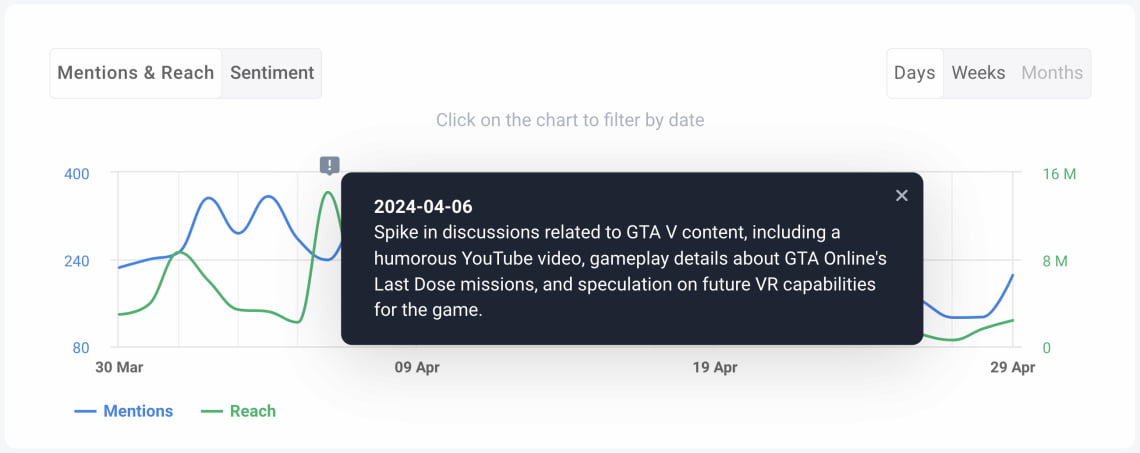
Non-social reach
Press monitoring refers to the media coverage outside social media platforms. Therefore, to analyze it properly, you should focus on non-social mentions.
Non-social mentions are all situations when someone uses your tracked keyword (i.e., your brand name) in online sources, such as news sites, websites, blogs, podcasts, videos, and so on.
If you use Brand24, you can easily access the most important data regarding your non-social mentions.
Just go to the Summary tab and look for the data from a given period.
Below, you can see the non-social mentions volume & reach for Rockstar Games gained in just 30 days.
Over 28 million non-social reach makes evident that this gaming company shouldn’t underestimate its presence outside social media!
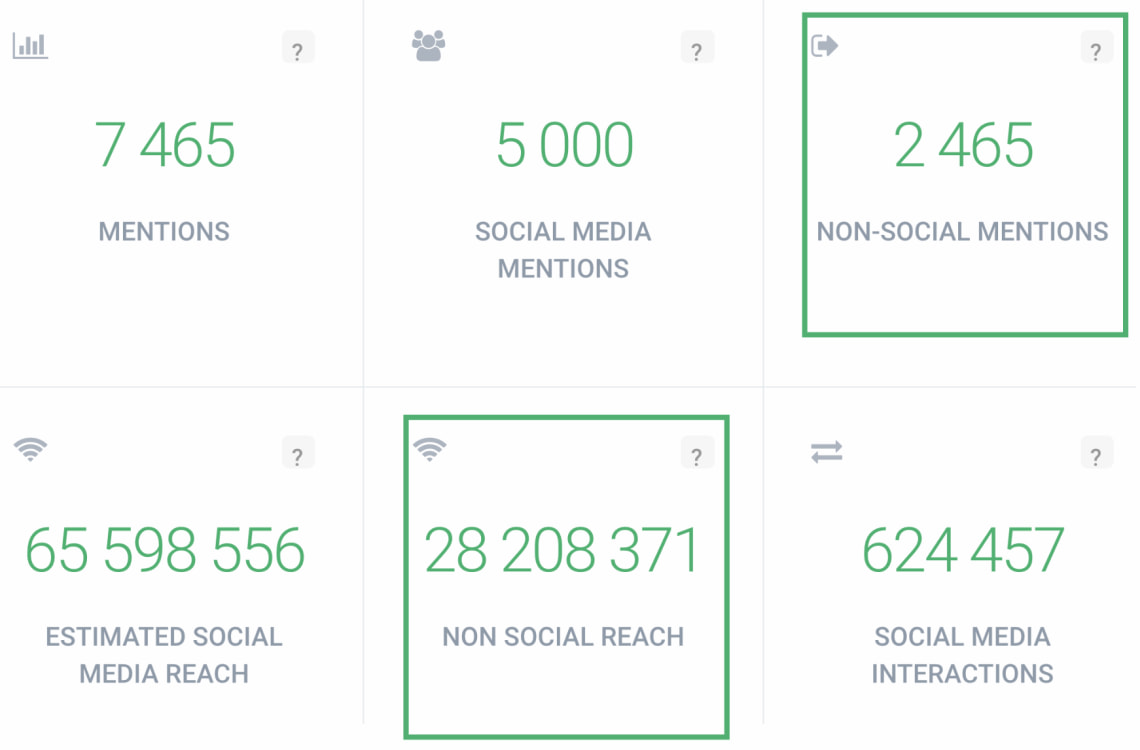
Track your mentions on & beyond social media!
Competitor analysis
Media monitoring helps companies gain insights into their competitors’ activities, strategies, and media presence.
By analyzing their competitors’ coverage, the company can identify strengths and weaknesses, benchmark their performance, and make data-driven decisions to stay competitive.
One example of how you could perform a competitor analysis is through Brand24’s Compare Projects feature.
Simply choose the project to benchmark and see what your brand looks like compared to your industry rivals.
I’ll show the example of two competitors in the field of sports cameras & personal drones: Chinese DJI and American GoPro.
Honestly, I didn’t expect DJI to outperform GoPro so much!
The Chinese company has generated nearly twice as many non-social mentions as its American competitor.
Thanks to this, DJI reached 23 million people more than GoPro.
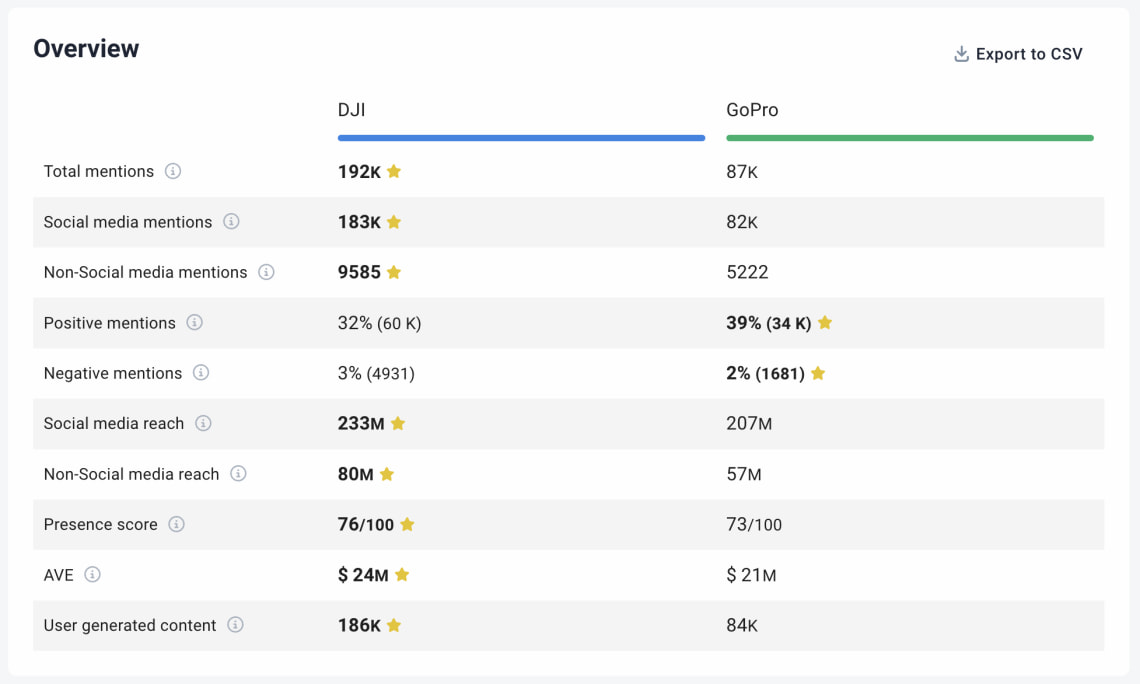
Read also: Competitor Analysis: All Why’s, How-to’s and More
Share of Voice
Share of Voice (SOV) is one of the primary marketing metrics to monitor your online presence.
And yes – it’s also applicable to your press coverage.
Ok, but what’s that?
In short, Share of Voice indicates your brand visibility across various marketing channels, including the press. But SOV doesn’t exist in a vacuum.
To rate it properly, you need a reference point: a single competitor, multiple competitors, or even the whole industry.
I want you to understand it properly, so let’s go back to our DJI vs. GoPro example. Again, I’ll use the help of Brand24’s Compare Projects feature.
To check their Share of Voice, just scroll down. Mark the “Non-social media” to exclude social platforms.
The results are confirm our previous conclusion – DJI has a larger SOV than GoPro!

Market Intelligence
Press monitoring provides valuable market intelligence by tracking news related to market trends, customer preferences, industry regulations, and new product launches. This information helps organizations understand their target audience, adapt their strategies, and identify new business opportunities.
Of course, these are only some examples of how you can use press monitoring. Be sure to follow our blog to learn more ways of utilizing monitoring media mentions to your benefit!
Be the first to discover market trends!
Why is media monitoring crucial for your business?
For the reasons mentioned above (and many more), monitoring online news can be a crucial part of your business strategy.
Why media monitoring?
First of all, you gain general knowledge about the latest industry trends, your competitors’ actions, and media coverage of your brand.
Secondly, you can measure your brand reputation and awareness and make data-driven marketing decisions for PR campaigns.
You can improve social selling campaigns by implementing social listening in your daily schedule.
You can perform competitor analysis based on their media reach.
Additionally, you can connect with your target audience by exploring brand mentions in the press and social media.
What’s more, you can avert a possible brand crisis by actively monitoring brand mentions in the press.
And many more instances of the benefits of press monitoring are mentioned on our blog.
Tips on online news monitoring
You can follow some tips to achieve maximum profit from online press monitoring. Here’s what you can do to improve your media monitoring strategy.
Set clear goals
Understand what you hope to achieve with media monitoring. Whether it’s managing brand reputation, tracking competitors, or identifying industry trends, knowing your goals will guide your strategy.
After you set your goals and be able to reach them, you can evaluate if your monitoring strategy is successful or not.
Use relevant keywords
Select a variety of relevant keywords, including your brand name, products, services, competitors, industry buzzwords, and any variations or common misspellings.
The most common keyword to monitor is your brand name, and many companies stop at that. To get the full image, use a media monitoring tool to track mentions of related keywords and your competitors. This way, you’ll get helpful insights about your market niche.
Consider context
Keywords may not always be used in the context you’re interested in. Set parameters to ensure the mentions are relevant to your brand or industry. Many media monitoring tools allow excluding certain keywords in your mentions tab to filter only what you are the most interested in.
Context analysis plays a huge role in extracting insights from a monitoring tool. The more advanced the tracking tool, the more data you can analyze.
Monitor competitors
Keep an eye on your competitors’ media presence. Understanding their tactics, successes, and failures can provide useful insights. Don’t focus only on your brand. Your competitors may be ahead of you in some media outlets, and you can easily miss that without press monitoring.
Keep an eye on industry trends
Beyond just monitoring your own brand and competitors, watch for wider industry trends, changes, or emerging topics. You can do it by monitoring relevant keywords. Good media monitoring tools offer keyword alerts that come directly to your inbox. Keep an eye out for that feature when choosing the tool.
Leverage the right tools
Invest in a good media monitoring tool that fits your needs and budget. Free tools like Google Alerts can be a good start, but for comprehensive monitoring, you may need a more advanced tool. Scroll down for a list of good and recommended social listening and media monitoring tools.
Try the best media monitoring tool!
Analyze and act
Don’t just gather data; analyze it. Look for patterns, sentiment, and influential voices. Use these insights to inform your strategists.
Raw brand and keyword mentions do not bring a lot of value, but if you have specific skills to analyze them in the right context, you gain useful knowledge that can bring you ahead of your competitors.
Be proactive
Use media monitoring to anticipate and manage crises before they escalate. Swift, well-informed responses can mitigate damage to your reputation.
If you are planning a PR campaign with specific keywords, use an online media monitoring tool to start a project for that keywords. This way, you will be able to track the campaign results from the very beginning.
Adjust over time
Your monitoring strategy should evolve. Regularly review and adjust your keywords, goals, and tools as needed. Online press monitoring is an ongoing process.
Train your team
Ensure that your team is familiar with the tools you’re using and knows how to interpret and act on the results. If you lack some skills, you can always ask the industry leaders for help. Don’t be afraid to reach out for new knowledge.
Online press monitoring tools
Monitoring the press manually can become a really mundane task, and nobody should blame you for seeking other solutions. Fortunately, there are many online tools for press and social media monitoring. Here are some of the most popular ones.
Brand24
Brand24 is an AI-powered media monitoring and social listening tool that will help you not only to catch online brand mentions but also give you a lot of valuable insights regarding your brand reputation.
If you are looking for a user-friendly tool for online press monitoring, Brand24 is definitely worth trying.
Not only will you receive a summary of the media coverage, but you’ll also get access to some analytics regarding your brand health, such as sentiment analysis, reach, AVE calculations, and many more.
Brand24 also offers keyword alerts, and you can create custom reports for your brand and social mentions.
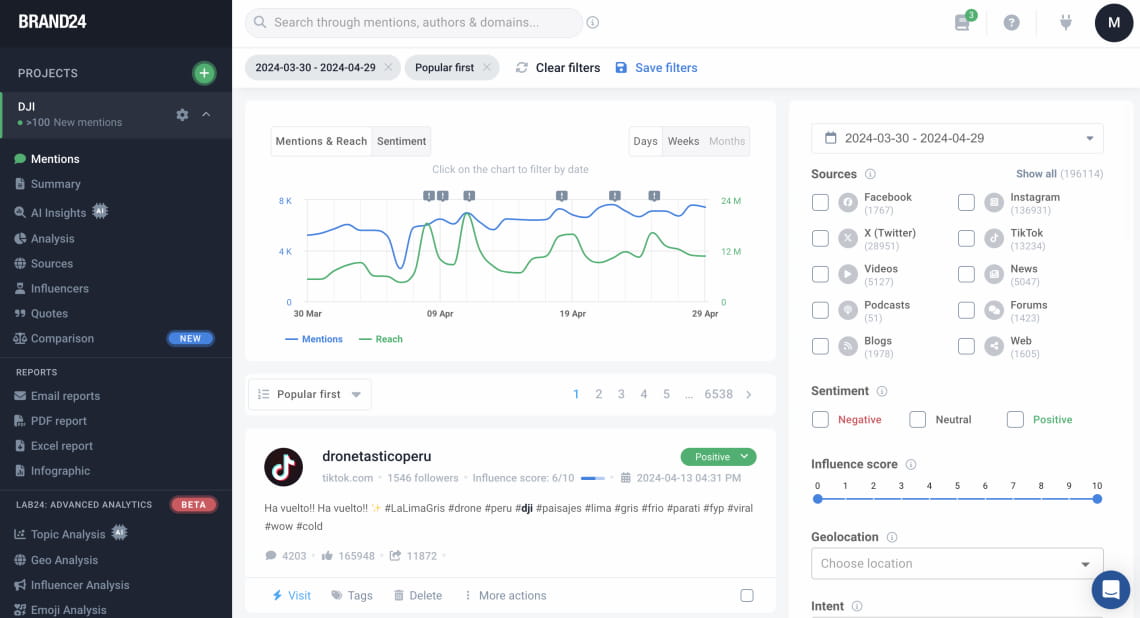
Start tracking what others talk about you now!
Brandwatch
Brandwatch is an advanced media intelligence tool designed for enterprise clients.
The suite includes media monitoring, brand management, consumer research, crisis management features, and many more. It’s an all-in-one tool for PR professionals and brand managers. It offers advanced analytics about your brand reputation and media exposure.
Brandwatch is aimed at big companies, and pricing is calculated depending on your individual needs.

Mention
Another useful media monitoring tool – Mention – is a simple mention-gathering app that will let you monitor news sources, blogs, forums, and social media.
If you do not care for advanced analytics provided by such tools as, for example, Brandwatch and need just a simple media monitoring tool to regularly check on press mentions, Mention is a solution for you.

Awario
Awario is another brand management tool that can be used for press monitoring. Similarly to Mention, it doesn’t come with advanced analytics features, but it’s definitely affordable and easy to use.
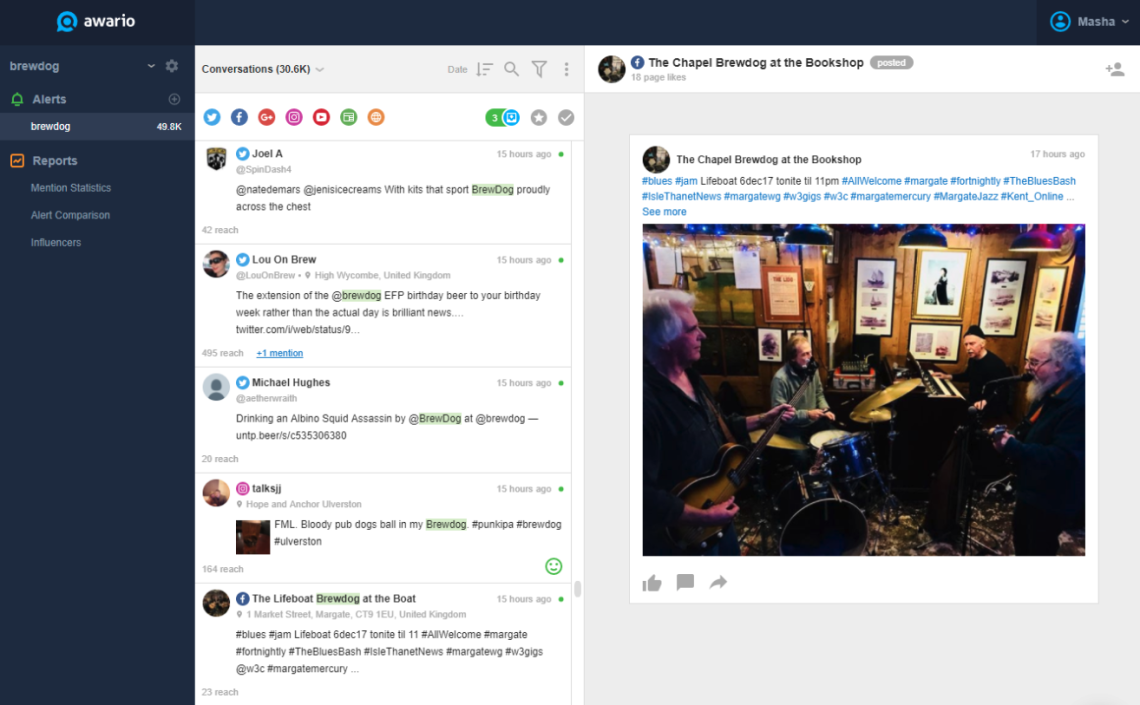
Prowly
Another useful tool for PR professionals is Prowly. It’s a slightly different take on media monitoring software than previously mentioned solutions. Prowly is, first and foremost, a PR management tool that includes a journalist database, advanced press release distribution features, and PR CRM.
Prowly is not a solution for collecting brand mentions; instead, it’s super useful for PR campaigns. For example, when you want to monitor press release distribution.
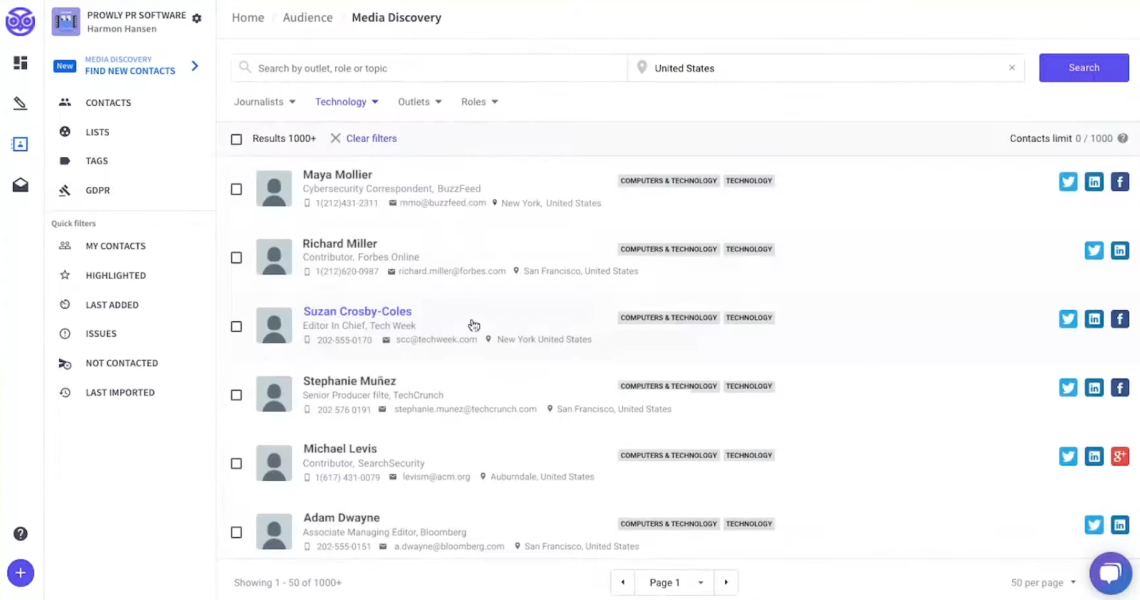
Google Alerts
Last but not least, it’s impossible to talk about the press or any other kind of media monitoring without mentioning Google Alerts – a simple and, most importantly, a free tool from Google.
Google Alerts lack many useful functions that are present in the paid tools, but if you only want to have a general idea of how often somebody mentions your brand in the online press, this might be just the solution you need.

Track your brand’s press mentions effortlessly!
Frequently Asked Questions
What is an example of media monitoring?
Media monitoring involves tracking the mentions and context of specific topics across different media forms.
For instance, tech startup Company X launches a new product and uses a media monitoring service to track public response. This service:
- Tracks mentions of the product across all media, including social media and traditional outlets.
- Performs sentiment analysis to determine if the feedback is positive, negative, or neutral.
- Compiles a report detailing the findings.
This data helps Company X understand public sentiment, shape future strategies, address negative feedback, and leverage positive feedback.
What is PR monitoring?
PR monitoring involves tracking a company’s image and the effectiveness of its PR strategies across different media platforms. This includes:
- Monitoring media coverage, both in quantity and sentiment.
- Tracking social media mentions and reactions.
- Evaluating the success of PR campaigns or events.
- Identifying and managing potential PR crises.
This data helps companies fine-tune their communication strategies, manage their public image, and respond appropriately to public sentiment.
Try the best press monitoring tool!
How do you do media monitoring?
Media monitoring can be achieved through a series of steps that involve the use of different tools and methodologies. Here’s a simplified overview:
- Define your goals. Decide what information you’re looking for. This could be mentions of your brand, your competitors, or a particular topic relevant to your industry.
- Identify relevant channels. Determine where your target audience is most active. This could be newspapers, magazines, online news sites, blogs, forums, or social media platforms.
- Choose your tools. Several tools exist for media monitoring, ranging from Google Alerts (which is free) to more sophisticated (and costly) tools like Brand24, Awario, or Brandwatch.
- Set up alerts. Using your chosen tool, set up alerts for specified keywords. The tool will then track these keywords across the selected channels and alert you when they are mentioned.
- Analyze data. Most tools will provide analytics that help you understand the reach, sentiment, and frequency of mentions.
- Take action: Use the information to make decisions about PR, marketing, product development, customer service, etc.
- Repeat. Media monitoring is an ongoing process, not a one-time task. Continually refine your keywords and channels based on the insights you gather.
Remember that the specific steps may vary depending on the complexity of your needs, the tools you’re using, and the media landscape of your industry.
Related articles

![What is AI Social Media Monitoring? Definition [Guide]](https://brand24.com/blog/app/uploads/2022/09/What-is-Social-Media-Monitoring.png)

![9 Steps to Strong Brand Awareness Strategy [2025]](https://brand24.com/blog/app/uploads/2020/12/15-The-ultimate-guide-to-brand-awareness-1400x660x2.png)